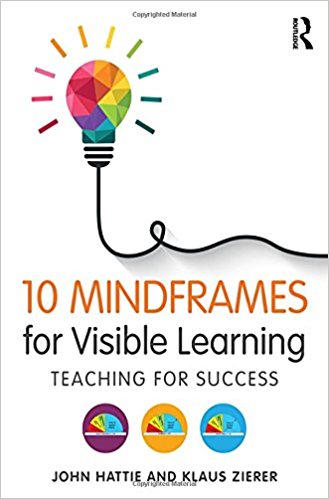 | 10 Mindframes for Visible Learning: Teaching for Success
by John Hattie & Klaus Zierer
The original Visible Learning research concluded that one of the most important influencers of student achievement is how teachers think about learning and their own role.
In Ten Mindframes for Visible Learning, John Hattie and Klaus Zierer define the ten behaviors or mindframes that teachers need to adopt in order to maximize student success.
These include:
- thinking of and evaluating your impact on students’ learning;
- the importance of assessment and feedback for teachers;
- working collaboratively and the sense of community;
- the notion that learning needs to be challenging;
- engaging in dialogue and the correct balance between talking and listening;
- conveying the success criteria to learners;
- building positive relationships.
These powerful mindframes, which should underpin every action in schools, are founded on the principle that teachers are evaluators, change agents, learning experts, and seekers of feedback who are constantly engaged with dialogue and challenge.
This practical guide, which includes questionnaires, scenarios, checklists, and exercises, will show any school exactly how to implement Hattie’s mindframes to maximise success.
Published: 15th December 2017
ISBN: 9781138635524
Number Of Pages: 180
TF
Regular price: 46.00
Discounted member price: 42.00
|
| 9781138635524 |
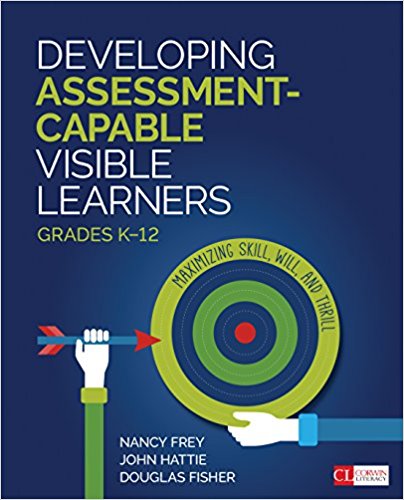 | Developing Assessment-Capable Visible Learners Grades K-12
Developing Assessment-Capable Visible Learners, Grades K-12: Maximizing Skill, Will, and Thrill
Author: Nancy Frey, John Hattie & Douglas Fisher
“When students know how to learn, they are able to become their own teachers.”
—Nancy Frey, Douglas Fisher, and John Hattie
Imagine students who describe their learning in these terms: “I know where I’m going, I have the tools I need for the journey, and I monitor my own progress.” Now imagine the extraordinary difference this type of ownership makes in their progress over the course of a school year.
This illuminating book shows how to make this scenario an everyday reality in your classroom — one that will significantly increase your students’ capacity to thrive as they take responsibility for their own learning.
With its foundation in principles introduced in the authors’ bestselling Visible Learning for Literacy, this resource delves more deeply into the critical component of self-assessment. Developing Assessment-Capable Visible Learners reveals
* The most effective types of assessment and how each can motivate students to higher levels of achievement
* How to introduce students to the tools they will use to support their own learning, along with the know-how they need to choose the right tool for any learning challenge
* How to create a classroom culture where errors are viewed as opportunities to learn
* The learning strategies, including cognitive, metacognitive, and motivational strategies, that fuel student progress, and how to give students opportunities to use them
* Real-world examples of the strategies and tools at work, through classroom scenarios contained in the book and online videos accessible via QR codes
As inspiring as it is practical, Developing Assessment-Capable Visible Learners gives you a clear strategy for empowering each of your students in shaping their own educational success.
Published: 14th February 2018
ISBN: 9781506389981
Number Of Pages: 184
Regular price: 60.00
Discounted member price: 55.00
|
| 9781506389981 |
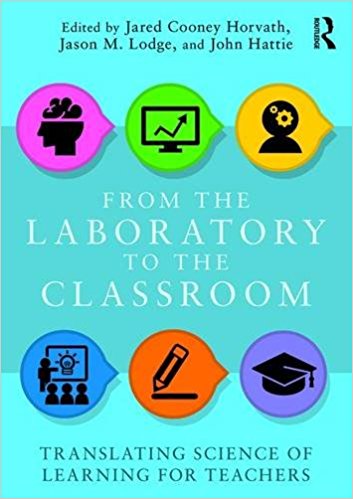 | From the Laboratory to the Classroom
Title: From the Laboratory to the Classroom: Translating Science of Learning for Teachers
Authors: Jared Cooney Horvath, Jason M. Lodge & John Hattie
Over recent years the field of Science of Learning has increased dramatically. Unfortunately, despite claims that this work will greatly impact education, very little research makes it into teacher practice. Although the reasons for this are varied, a primary concern is the lack of a proper translation framework.
From the Laboratory to the Classroom aims to consolidate information from many different research disciplines and correlate learning principles with known classroom practices in order to establish explanatory foundations for successful strategies that can be implemented into the classroom. It combines theoretical research with the diverse and dynamic classroom environment to deliver original, effective and specific teaching and learning strategies and address questions concerning what possible mechanisms are at play as people learn.
Divided into five sections, chapters cover:
- A Framework for Organizing and Translating Science of Learning Research
- Motivation and Attention as Foundations for Student Learning
- Memory and Metamemory Considerations in the Instruction of Human Beings
- Science of Learning in Digital Learning Environments
- Educational Approaches for Students Experiencing Learning Difficulties and Developmental Characteristics of Gifted Children
- Brain, Behaviour and Classroom Practice
- Forging Research/Practice Relationships via Laboratory Schools
This fascinating text gathers an international team of expert scientists, teachers, and administrators to present a coherent framework for the vital translation of laboratory research for educational practice.
Applying the Science of Learning framework to a number of different educational domains, it will be an essential guide for any student or researcher in education, educational psychology, neuropsychology, educational technology and the emergent field of neuroeducation.
Published on: 10 August 2017
ISBN: 9781138649644
Number Of Pages: 312
ACEL RRP: $103.00
Regular price: 30.00
|
| 9781138649644 |
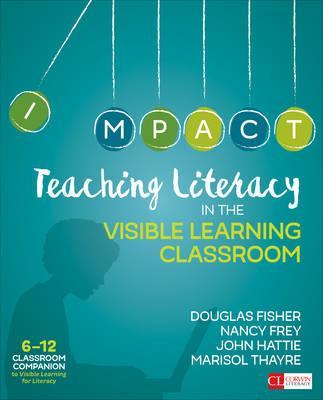 | Teaching Literacy in the Visible Learning Classroom 6-12
Teaching Literacy in the Visible Learning Classroom, Grades 6-12
Douglas Fisher, Nancy Frey, John Hattie and Marisol Thayre
It could happen at 10:10 a.m. in the midst of analyzing a text, at 2:00, when listening to a students’ debate, or even after class, when planning a lesson. The question arises: How do I influence students’ learning–what’s going to generate that light bulb Aha-moment of understanding?
In this sequel to their megawatt best seller Visible Learning for Literacy, Douglas Fisher, Nancy Frey, and John Hattie help you answer that question by sharing structures and tools that have high-impact on learning, and insights on which stage of learning they have that high impact.
With their expert lessons, video clips, and online resources, you can design reading and writing experiences that foster in your students deeper and more sophisticated expressions of literacy:
• Mobilizing Visible Learning: Use lesson design strategies based on research that included 500 million plus students to develop self-regulating learners able to “see” the purpose of what they are learning—and their own progress.
• Teacher Clarity: Articulate daily learning intentions, success criteria, and other goals; understand what your learners understand, and design high-potency experiences for all students.
• Direct Instruction: Embrace modeling and scaffolding as a critical pathway for students to learn new skills and concepts.
• Teacher-Led Dialogic Instruction: Guide reading, writing, listening, speaking, and thinking by using strategic questioning and other teacher-led discussion techniques to help learners to clarify thinking, discuss, debate, and goal-set.
• Student-Led Dialogic Learning: Promote intellectual, social, and creative growth with peer-mediated learning experiences that transfer to other subject areas, including history, science, math, and the visual and performing arts.
• Independent Learning: Ensure that students deepen learning by designing relevant tasks that enable them to think metacognitively, set goals, and develop self-regulatory skills.
• Tools to Use to Determine Literacy Impact: Know what your impact truly is with these research-based formative assessments for 6-12 learners.
With Teaching Literacy in the Visible Learning Classroom, take your students from surface to deep to transfer learning. It’s all about using the most effective practices—and knowing WHEN those practices are best leveraged to maximize student learning.
Published: 16th May 2017
ISBN: 9781506332376
Number Of Pages: 232
BT
Regular price: 60.00
Discounted member price: 55.00
|
| 9781506332376 |
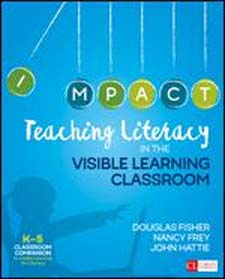 | Teaching Literacy in the Visible Learning Classroom, K-5
Teaching Literacy in the Visible Learning Classroom, Grades K-5
by Douglas Fisher, Nancy Frey and John Hattie
It could happen at 10:10 a.m. in the midst of interactive writing, at 2:30, when listening to readers, or even after class, when planning a lesson. The question arises: How do I influence students’ learning–what’s going to generate that light bulb Aha-moment of understanding?
In this sequel to their megawatt best seller Visible Learning for Literacy, Douglas Fisher, Nancy Frey, and John Hattie help you answer that question by sharing structures and tools for effective literacy instruction that have high-impact on learning - and insights on which stage of learning they have that high impact.
With their expert lessons, video clips, and online resources, you can deliver sustained, comprehensive experiences in phonics, guided reading, interactive writing, content-area discussions - in virtually all you teach:
Mobilizing Visible Learning: Use lesson design strategies based on research that included 500 million plus students to develop self-regulating learners able to “see” the purpose of what they are learning - and their own progress.
Teacher Clarity: Articulate daily learning intentions, success criteria, and other goals; understand what your learners understand, and design high-potency experiences for all students.
Direct Instruction: Embrace modeling and scaffolding as a critical pathway for students to learn new skills and concepts.
Teacher-Led Dialogic Instruction: Guide reading, writing, and thinking by using questioning and other teacher-led discussion techniques to help learners to clarify thinking, disagree respectfully, and reach consensus.
Student-Led Dialogic Learning: Foster cognitive growth with peer-mediated learning - reciprocal teaching, QAR, fish bowl, and more.
Independent Learning: Ensure that students deepen learning by designing relevant tasks that enable them to think metacognitively, set goals, and develop self-regulatory skills.
Tools to Use to Determine Literacy Impact: Know what your impact truly is with these research-based formative assessments for K-5 learners.
With Teaching Literacy in the Visible Learning Classroom, take your students from surface to deep to transfer learning. It’s all about using the most effective practices - and knowing WHEN those practices are best leveraged to maximize student learning.
272 pages | May 2017
BT
Regular price: 60.00
Discounted member price: 52.00
|
| 9781506332369 |
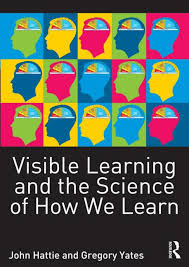 | Visible Learning and the Science of How We Learn
Title: Visible Learning and the Science of How We Learn
Authors - John Hattie, Gregory C. R. Yates
On publication in 2009, John Hattie’s Visible Learning presented the biggest ever collection of research into what actually work in schools to improve children’s learning. Not what was fashionable, not what political and educational vested interests wanted to champion, but what actually produced the best results in terms of improving learning and educational outcomes. It became an instant bestseller and was described by the TES as revealing education’s ‘holy grail’.
Now in this latest book, John Hattie has joined forces with cognitive psychologist Greg Yates to build on the original data and legacy of the Visible Learning project, showing how it’s underlying ideas and the cutting edge of cognitive science can form a powerful and complimentary framework for shaping learning in the classroom and beyond.
Visible Learning and the Science of How We Learn explains the major principles and strategies of learning, outlining why it can be so hard sometimes, and yet easy on other occasions. Aimed at teachers and students, it is written in an accessible and engaging style and can be read cover to cover, or used on a chapter-by-chapter basis for essay writing or staff development.
The book is structured in three parts – ‘learning within classrooms’, ‘learning foundations’, which explains the cognitive building blocks of knowledge acquisition and ‘know thyself’ which explores, confidence and self-knowledge. It also features extensive interactive appendices containing study guide questions to encourage critical thinking, annotated bibliographic entries with recommendations for further reading, links to relevant websites and YouTube clips. Throughout, the authors draw upon the latest international research into how the learning process works and how to maximise impact on students, covering such topics as:
1. teacher personality;
2. expertise and teacher-student relationships;
3. how knowledge is stored and the impact of cognitive load;
4. thinking fast and thinking slow;
5. the psychology of self-control;
6. the role of conversation at school and at home;
7. invisible gorillas and the IKEA effect;
8. digital native theory;
9. myths and fallacies about how people learn.
This fascinating book is aimed at any student, teacher or parent requiring an up-to-date commentary on how research into human learning processes can inform our teaching and what goes on in our schools. It takes a broad sweep through findings stemming mainly from social and cognitive psychology and presents them in a usable format for students and teachers at all levels, from preschool to tertiary training institutes.
ISBN: 9780415704991
No of Pages: 368
Publish Date: 04 May 2015
Routledge/Taylor & Francis
Regular price: 64.00
Discounted member price: 58.00
|
| ACELOffice2 |
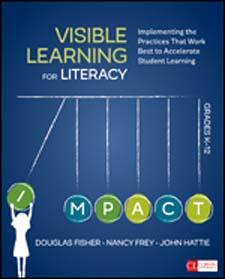 | Visible Learning for Literacy Grades K-12
Visible Learning for Literacy, Grades K-12: Implementing the Practices That Work Best to Accelerate Student Learning
Douglas Fisher, Nancy Frey and John Hattie
“Every student deserves a great teacher, not by chance, but by design” — Douglas Fisher, Nancy Frey, & John Hattie
What if someone slipped you a piece of paper listing the literacy practices that ensure students demonstrate more than a year’s worth of learning for a year spent in school? Would you keep the paper or throw it away?
We think you’d keep it. And that’s precisely why acclaimed educators Douglas Fisher, Nancy Fry, and John Hattie wrote Visible Learning for Literacy. They know teachers will want to apply Hattie’s head-turning synthesis of more than 15 years of research involving millions of students, which he used to identify the instructional routines that have the biggest impact on student learning.
These practices are “visible” for teachers and students to see, because their purpose has been made clear, they are implemented at the right moment in a student’s learning, and their effect is tangible. Yes, the “aha” moments made visible by design.
With their trademark clarity and command of the research, and dozens of classroom scenarios to make it all replicable, these authors apply Hattie’s research, and show you:
- How to use the right approach at the right time, so that you can more intentionally design classroom experiences that hit the surface, deep, and transfer phases of learning, and more expertly see when a student is ready to dive from surface to deep.
- Which routines are most effective at specific phases of learning, including word sorts, concept mapping, close reading, annotating, discussion, formative assessment, feedback, collaborative learning, reciprocal teaching, and many more.
- Why the 8 mind frames for teachers apply so well to curriculum planning and can inspire you to be a change agent in students’ lives—and part of a faculty that embraces the idea that visible teaching is a continual evaluation of one’s impact on student’s learning.
“Teachers, it’s time we embrace the evidence, update our classrooms, and impact student learning in wildly positive ways,” say Doug, Nancy, and John. So let’s see Visible Learning for Literacy for what it is: the book that renews our teaching and reminds us of our influence, just in time.
216 pages | Apr 2016
Regular price: 59.00
Discounted member price: 55.00
|
| 9781506332352 |
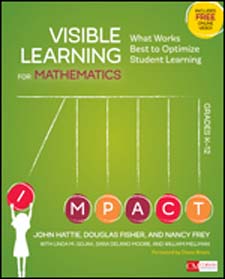 | Visible Learning for Mathematics Grades K-12
Visible Learning for Mathematics, Grades K-12: What Works Best to Optimize Student Learning
John Hattie, Douglas Fisher, Nancy Frey, Linda Gojak, Sara Moore and William Mellman
Rich tasks, collaborative work, number talks, problem-based learning, direct instruction…with so many possible approaches, how do we know which ones work the best? In Visible Learning for Math, six acclaimed educators assert it’s not about which one—it’s about when—and show you how to design high-impact instruction so all students demonstrate more than a year’s worth of mathematics learning for a year spent in school.
That’s a high bar, but with the amazing K-12 framework here, you choose the right approach at the right time, depending upon where learners are within three phases of learning: surface, deep, and transfer. This results in“visible” learning because the effect is tangible. The framework is forged out of current research in mathematics combined with John Hattie’s synthesis of more than 15 years of education research involving 300 million students.
Chapter by chapter, and equipped with video clips, planning tools, rubrics, and templates, you get the inside track on which instructional strategies to use at each phase of the learning cycle:
Surface learning phase: When—through carefully constructed experiences—students explore new concepts and make connections to procedural skills and vocabulary that give shape to developing conceptual understandings.
Deep learning phase: When—through the solving of rich high-cognitive tasks and rigorous discussion—students make connections among conceptual ideas, form mathematical generalizations, and apply and practice procedural skills with fluency.
Transfer phase: When students can independently think through more complex mathematics, and can plan, investigate, and elaborate as they apply what they know to new mathematical situations.
To equip students for higher-level mathematics learning, we have to be clear about where students are, where they need to go, and what it looks like when they get there. Visible Learning for Math brings about powerful, precision teaching for K-12 through intentionally designed guided, collaborative, and independent learning.
Edition Number: 1
Published: 1st November 2016
ISBN: 9781506362946
Number Of Pages: 304
BT
Regular price: 58.00
Discounted member price: 54.00
|
| 9781506362946 |
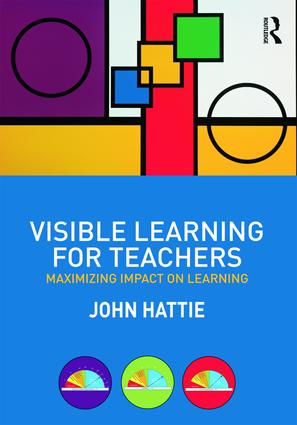 | Visible Learning for Teachers: Maximizing Impact on Learning
Visible Learning for Teachers - Maximizing Impact on Learning
Author: John Hattie
John Hattie’s ground-breaking book Visible Learning synthesised the results of more than fifteen years research involving millions of students and represented the biggest ever collection of evidence-based research into what actually works in schools to improve learning.
Visible Learning for Teachers takes the next step and brings those ground breaking concepts to a completely new audience. Written for students, pre-service and in-service teachers, it explains how to apply the principles of Visible Learning to any classroom anywhere in the world. The author offers concise and user-friendly summaries of the most successful interventions and offers practical step-by-step guidance to the successful implementation of visible learning and visible teaching in the classroom.
This book:
1. links the biggest ever research project on teaching strategies to practical classroom implementation;
2. champions both teacher and student perspectives and contains step by step guidance including lesson preparation, interpreting learning and feedback during the lesson and post lesson follow up;
3. offers checklists, exercises, case studies and best practice scenarios to assist in raising achievement; and
4. includes whole school checklists and advice for school leaders on facilitating visible learning in their institution; and
5. now includes additional meta-analyses bringing the total cited within the research to over 900;
6. comprehensively covers numerous areas of learning activity including pupil motivation, curriculum, meta-cognitive strategies, behaviour, teaching strategies, and classroom management.
Visible Learning for Teachers is a must read for any student or teacher who wants an evidence based answer to the question; ‘how do we maximise achievement in our schools?’
Edition Number: 1
Published: 13th December 2011
ISBN: 9780415690157
Number Of Pages: 296
TF
Regular price: 53.00
Discounted member price: 45.00
|
| TANDF3 |
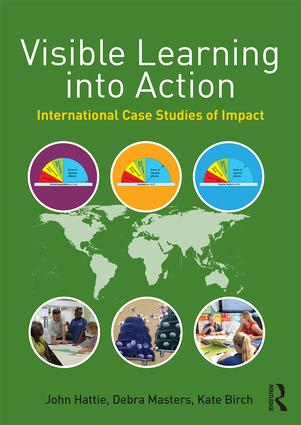 | Visible Learning into Action
Visible Learning into Action - International Case Studies of Impact
Authors - John Hattie, Deb Masters and Kate Birch
Recently at the Visible Learning Conference, Professor John Hattie stood up in his opening address and said, "I’m looking at you all and thinking ‘What if I got this wrong?’" I feel the same way when educators ask to visit and I always end up in the same place – that Keilor Views is a living, breathing example that he didn’t. -- Charles Branciforte, Principal of Keilor Views Primary School, Melbourne, Australia
Visible Learning into Action takes the next step in the evolving Visible Learning story. It translates one of the biggest and most critically acclaimed education research projects ever undertaken into case studies of actual success stories, implementing John Hattie’s ideas in the classrooms of schools all around the world.
The evidenced case studies presented in this book describe the Visible Learning journeys of fifteen schools from Australia, USA, Hong Kong, UK, Sweden, New Zealand and Norway and are representative of the VL international community of schools in their quest to ensure all of their students exceed their potential for academic success. Each school’s story will inform and inspire, bringing to life the discussions, actions and reflections from leaders, teachers, students and families.
This book features extensive, interactive appendices containing study guide questions to encourage critical thinking, annotated endnotes with recommendations for further reading and links to YouTube and relevant websites. Drawing on the latest research into the major principles and strategies of learning, this essential resource is structured into five parts:
1. Know thy impact
2. Effective feedback
3. Visible learners
4. Inspired and passionate teachers
5. The Visible Learning School
Visible Learning into Action is aimed at any student, teacher or parent requiring an up-to-date commentary on how research into human learning processes can inform our teaching and what goes on in our schools.
318 pages | Oct 2015
tf
Regular price: 25.00
Discounted member price: 20.00
|
| TANDF2 |